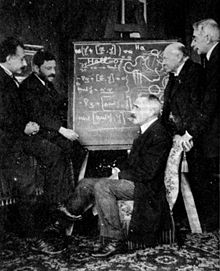Paul Langevin
Paul Langevin | |
|---|---|
Joseph John Thomson Gabriel Lippmann | |
| Doctoral students | Louis de Broglie Léon Brillouin |
| Signature | |
Paul Langevin[1] (/lænʒˈveɪn/;[2] French: [pɔl lɑ̃ʒvɛ̃]; 23 January 1872 – 19 December 1946) was a French physicist who developed Langevin dynamics and the Langevin equation. He was one of the founders of the Comité de vigilance des intellectuels antifascistes, an anti-fascist organization created after the 6 February 1934 far right riots. Being a public opponent of fascism in the 1930s resulted in his arrest and being held under house arrest by the Vichy government for most of World War II. Langevin was also president of the Human Rights League (LDH) from 1944 to 1946, having recently joined the French Communist Party.
He was a doctoral student of Pierre Curie and later a lover of widowed Marie Curie. He is also known for his two US patents with Constantin Chilowsky in 1916 and 1917 involving ultrasonic submarine detection.[3] He is entombed at the Panthéon.
Life
Langevin was born in

Langevin is noted for his work on
In 1898, he married Emma Jeanne Desfosses, and together they had four children, Jean, André, Madeleine and Hélène.
In 1910, he reportedly had an affair with the then-widowed
In 1933, he had a son with physicist Eliane Montel (1898–1993), Paul-Gilbert Langevin, who became a renowned musicologist.
His daughter, Hélène Solomon-Langevin, was arrested for Resistance activity and survived several concentration camps. She was on the same convoy of female political prisoners as Marie-Claude Vaillant-Couturier and Charlotte Delbo.

Submarine detection
In 1916 and 1917, Paul Langevin and Chilowsky filed two US patents disclosing the first ultrasonic submarine detector using an electrostatic method (singing condenser) for one patent and thin quartz crystals for the other. The amount of time taken by the signal to travel to the enemy submarine and echo back to the ship on which the device was mounted was used to calculate the distance under water.
In 1916,
See also
- relativistic physics
- Langevin dynamics
- Langevin equation
- Langevin function
- Brillouin and Langevin functions
- Solvay Conference
- Brownian motion
- Special relativity
- Institut Laue–Langevin
References
- ^ JSTOR 769027.
- ^ "Langevin": entry in the American Heritage Science Dictionary, 2002.
- ^ S2CID 56655834.
- ^ ESPCI ParisTech Alumni 1891. espci.org
- ^ He may not have been formally entered as a member of the university, as he is not found in John Venn's Alumni Cantabrigienses
- ISBN 9780387951751.
- ISBN 9789400938755. Retrieved 13 December 2017.
- ^ Langevin, P. (1911), "The Evolution of Space and Time", Scientia, X: 31–54 (translated by J. B. Sykes, 1973 from the original French: "L'évolution de l'espace et du temps").
- ^ Robert Reid (1978) [1974] Marie Curie, pp. 44, 90.
- ISBN 0674032934. p. 43.
- ISBN 0-8419-0977-6.
- ISBN 0-434-60503-4.
- S2CID 34769956.
Sources
- Asimov's Biographical Encyclopedia of Science and Technology, ISBN 0-385-17771-2.
- References to the affair with Marie Curie is found in Françoise Giroud (Davis, Lydia trans.), Marie Curie: A life, Holmes and Meier, 1986, ISBN 0-434-60503-4.
- Wolfram research biographical entry by Michel Barran.
- Annotated bibliography for Niels Bohr from the Alsos Digital Library for Nuclear Issues
Further reading
- Julien Bok and Catherine Kounelis (2007). "Paul Langevin (1872–1946) – From Montmartre to the Panthéon: The Paris journey of an exceptional physicist" (PDF). Europhysics News. Vol. 38, no. 1.
- "In memory of Paul Langevin". London. 1947.
External links
 Media related to Paul Langevin at Wikimedia Commons
Media related to Paul Langevin at Wikimedia Commons Works by or about Paul Langevin at Wikisource
Works by or about Paul Langevin at Wikisource
